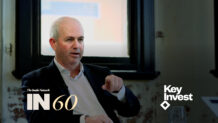The role and outlook for credit in 2021
Michael Karagianis who is the head of NFP and Retail Partnerships at JANA Investment Advisers presented “The role and outlook for credit” at The Inside Network’s third Masterclass session this year. His message to investors is to prepare for further volatility during the COVID-19 recovery.
Global interest rates are at historic lows as central banks poured liquidity into markets to help stimulate economies around the world. This drove strong returns from bonds to date. Credit spreads have compressed as investors hunt for yield which in turn brings down future return expectations. Michael says “easy liquidity, recovering equity markets, and the hunt for yield has driven credit spreads back towards their pre -Covid lows.”
Michael says he is concerned, “that markets remain highly uncertain and whether this recovery can be sustained for much longer. The bounce back is resembling a lot like FOMO (fear of missing out) or TINA (there is no alternative) triggered by massive government stimulus.”
There are still ongoing concerns surrounding the damage caused by COVID-19, with possible outbreaks still on the horizon and not mention rising inflation and low interest rates. Given that markets are once again pricing in perfection in an imperfect world, it’s an awful lot of good news that may not eventuate.
For this reason, Michael believes investors should be holding credit in their portfolios. Why? Because fixed income is traditionally considered a defensive portfolio exposure. It returns stable income and acts as a risk anchor when growth assets decline in value. Fixed income is however not homogeneous, it ranges from high quality / low risk (sovereign bonds) to low quality / higher risk (high yield / subordinated debt) and plenty in between. These differing fixed income investments can behave very differently in varying market circumstances and investors should be aware of this.
Michael says “In general as you move down the credit spectrum the risk of default and potential capital loss increases but the compensating yield (spread) rises. However, the correlation with risk assets also tends to increase notably in stressed market environments – credit is better viewed as “middle risk” rather than “defensive” assets.”

Government bonds aren’t of great value because yields are generally less than 1%. Look for investments that are relatively uncorrelated to shares to help your portfolio withstand another share market collapse. This is where credit markets come into play. “Credit is less overvalued than some asset classes and provides some yield enhancement.” However, investors need to be cautious and not load up on too much credit in their portfolios in-case “central banks start withdrawing liquidity and the economic cycle falters and equity market volatility escalates”.
JANA’s Asset Allocation views

According to Karagianis the outlook for credit markets will be closely tied to four factors:
- The actions of central banks.
- The economic cycle.
- Investor appetite for risk assets.
- The yield on risk free assets.
Advisers need to be cautious. There are concerns of investors being sucked into a false sense of security following the swift market recovery. The truth is markets remain unstable given a long list of concerns that could easily materialise. It is for that reason, Michael believes that investors, should prepare their portfolios for continued volatility ahead.










